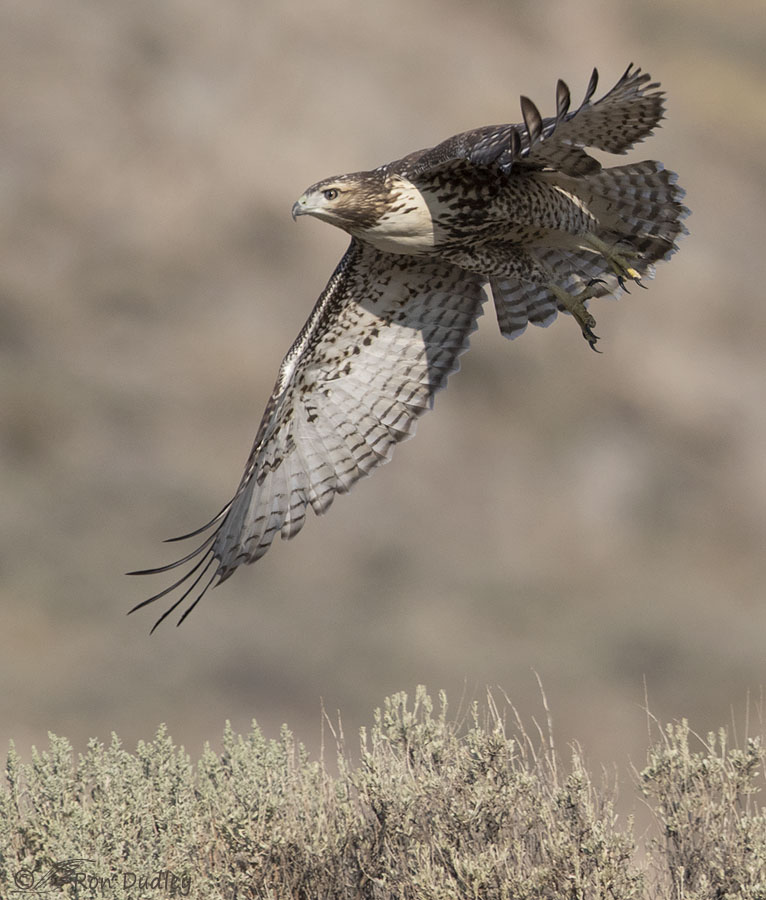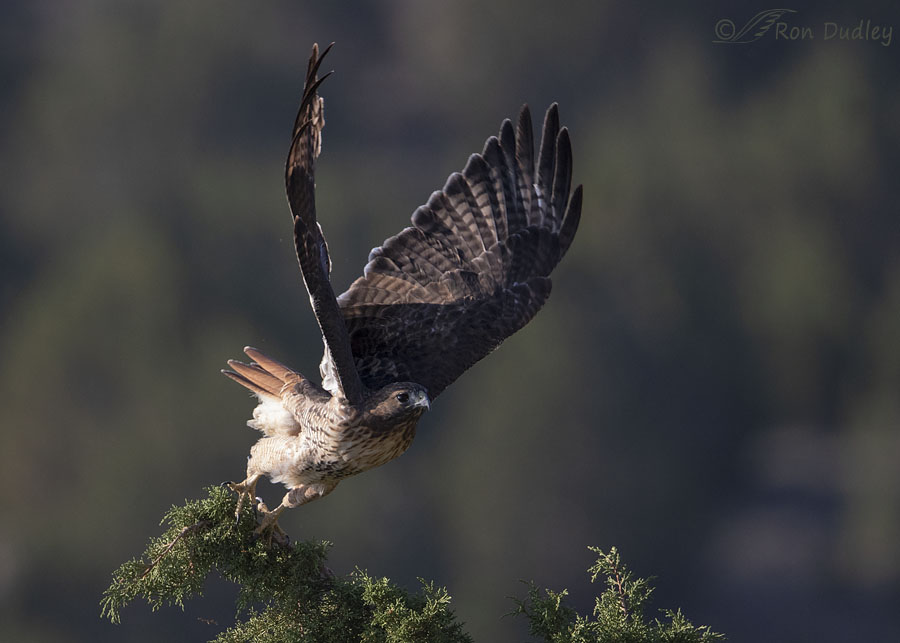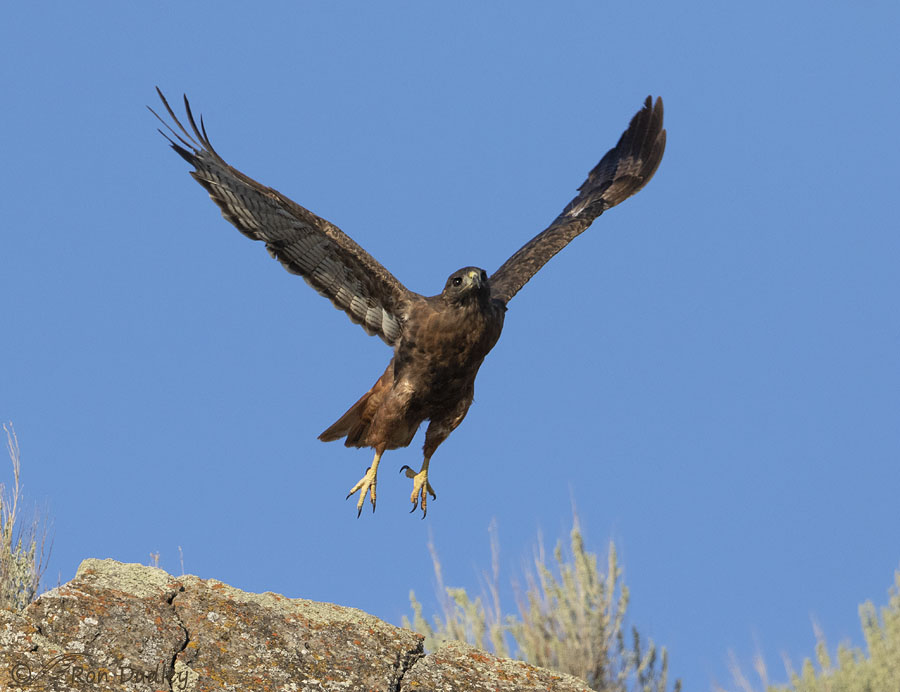A juvenile, an adult and a rufous morph.
The Red-tailed Hawk is the most variably plumaged raptor in North America with up to 16 subspecies recognized by various authorities, in addition to age related variations. Here’s a small, very small, sampling. Each of these three photos was taken in northern Utah in the last two weeks.

1/2500, f/7.1, ISO 500, Canon 7D Mark II, Canon EF 500mm f/4L IS II USM + EF 1.4 III Extender, not baited, set up or called in
As I mentioned, some of the variations in red-tails are age related. This is an immature light morph, photo taken soon after takeoff. The composition of this version of the photo is a little atypical for me because I wanted to include the sagebrush at the bottom of the frame to ground the bird.

1/2000, f/5.6, ISO 800, Canon 7D Mark II, Canon EF 500mm f/4L IS II USM + EF 1.4 III Extender, not baited, set up or called in
This is an adult taking off from a juniper and showing off the namesake red tail of mature individuals of the species. Also note the dark eye.
Occasionally some of my readers accuse me of being too nitpicky about my images because I often point out and complain about their flaws. Well, I like this one despite its flaws. The image quality isn’t great, the hawk’s head and eye could be a little sharper and the sidelight is strong – to the point that I had to do more processing of the image than I like to in order to tone down the extreme lighting contrasts in the photo.
But there’s something about this shot that draws me in. It’s probably a combination of things, including the spotlight on the hawk’s face and eye with enough light there to even get a catch light in the eye. I also like the dark, foreboding background.

1/2500, f/7.1, ISO 800, Canon 7D Mark II, Canon EF 500mm f/4L IS II USM + EF 1.4 III Extender, not baited, set up or called in
This is an adult rufous morph red-tail taking off from some rocks above me.
This photo and photo #1 were taken within 30 minutes of each other on the same morning and in the same area so it’s very possible that this rufous adult is one of the parents of the immature light morph in the first photo.
Rufous morphs producing light morph offspring and vice versa. The biologist in me wishes I knew how the genetics of all that works.
Ron


That burst of light in photo #2 is really an eye-catcher.
Hate being so late to the party, especially when Red-tails are involved! But must add my belated thanks for your post of these three wonderful photos. I very much like both the first and second images, but #3 reminds me (fondly) of the beautiful dark morph adult Red-tail I was lucky enough to release a few weeks ago for Ojai Raptor Center. She was a stunner!
Wow, releasing a dark morph red-tail, that must have been a memorable experience for you, Chris. Another one for the gene pool!
Three fabulous images! I keep going back to the second shot. It’s incredibly dramatic with the interplay of light and dark. The angle of the bird’s takeoff makes it seem to me as if the light is actually pushing the hawk off that juniper.
And I agree with the biologist in you. It would be fun to see some Punnett Squares. 🙂
Hard to pick a favorite, but the underwing feather pattern in the last photo stood out for me.
I haven’t seen any Red-tailed Hawks here lately. I wonder if it’s because of all the wildfires north and south of here.
The worst thing about getting new hardwood floors installed is the first ding. But then they multiply over time and give it character. At least that’s what I tell myself.
Lyle, if dings give floors character maybe I should have kept my old floors. Talk about character! 🙂
I loved all of the shots–and to me, the last is somehow a distillation of JOY !
Thank you, Kris.
Good. Thanks, Kris.
Very interesting and educational. Just a quick look without reading anything yet I thought #1 was our Ferruginous back for another visit. I love #2. The way the tail feathers are exposed to the light, and just that little strip of light across the face and eye, and then the very dark background. Beautiful.
Thank you, Everett. There are dark morph Ferrugs that can look somewhat similar to that bird but among other differences they would be significantly larger than a red-tail.
How I love the variations. And the power and majesty which is so evident.
I hope your back is improving and the floor modifications are going well.
Thanks, EC. Up to this point my back is holding up about as well as I could expect under these conditions.
So far the installer has just been tearing out old floor coverings and bringing the subfloor up to requirements for the new flooring. Today should be the big install.
Beautiful images all! The 2nd one REALLY grabs my attention! 🙂 It all comes together and the light hitting it’s eye and part of it’s face sets that area off. 🙂
Judy, I’m glad to know that some folks, including you, are already saying they like that shot. I thought it might be just me…
That first shot was almost heart-stoppingly gorgeous and the 2nd and 3rd are also powerful. And your discussion of your thoughts as you take and process these is not, to me, in any way negative or annoying or distracting. Rather it allows me to draw closer as if I were inside your head for those few moments. As a photographer myself it allows me to put myself in your space there and therefore doubles my enjoyment. Without those thoughts, those musings, these would be just another set of pretty pictures on Flickr or Instagram. Context is everything. Thanks for sharing settings, shots and thoughts.
YES. I agree with you. Big time.
Beautiful and informative! I especially love the movement, rhythm, sweep, and colors of the second. A real beautiful photo to my mind.
Thanks, Ron
Thank you, Mary.
Many thanks for these three images – would love to see more! You all out West have the grand array of Red-tail variations – love it! Wish we had more here in the East.
Only once in my life when traveling out West did I see a Red-tail similar to your last image! Man, what a beautiful bird!
“Man, what a beautiful bird”
The dark or rufous morphs get your attention don’t they Dick.